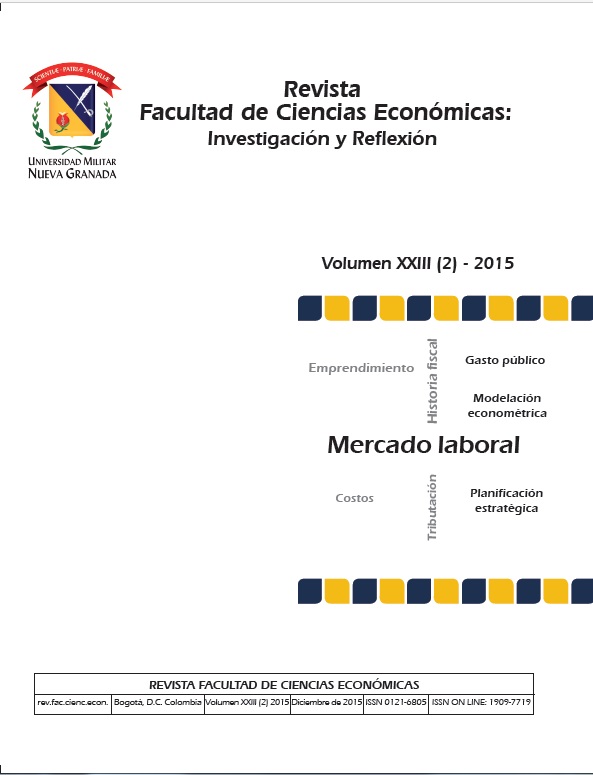Manufacturing sector´s cyclical synchronization of mexico and the united states from an autoregressive nonlinear perspective including smooth transition
Abstract
The aim of this paper is to validate the Smooth Transition Auto Regressive (STAR) model for the analysis of cyclical synchronization of the manufacturing sector in the United States with Mexico, from trade liberalization in the latter. To this end the literature on the STAR methodology is reviewed and theoretical and practical contributions regarding this are described. Theoretically it is concluded that due to its inherent linear structure, the STAR models are able to guide the researcher toward choosing the appropriate methodology to model the real behavior of the data; also thanks to its non-linear component they have the ability to model asymmetric cyclical behavior of the series.Downloads
References
Alonso, M. A. (2005). Teorías monetarias del ciclo económico en el marco de la literatura sobre ciclos económicos, Revista Libertas, 12 (43). Recuperado de http://www.eseade.edu.ar/servicios/Libertas/3_9_Alonso%20Neira.pdf
Álvarez I. & Da Silva, N. (2008). Ciclo del PIB ¿Cómo evaluar el método de estimación?. Instituto de Estadística, Universidad de la República, Uruguay, serie de documentos de trabajo DT (08/02). Recuperado de http://www.iesta.edu.uy/wp-content/uploads/2010/03/0802.pdf
Arango, L. & Melo, L. (2006). Expansions and Contractions in some Latin American countries: a view through non-linear models. Colombia: Banco de la República.
Arcarons, J., & Calonge, S. (2007). Microeconometría. Introdución y Aplicaciones con Excel. Delta Publicaciones.
Argandoña, A., Gamez, C. y Mochon, F. (1996). Macroeconomía avanzada II: ciclos económicos. Madrid, España: Ed. Mc Graw Hill.
Avella, M. & Fergusson, L. (2004). El ciclo económico. Enfoques e Ilustraciones. Los ciclos económicos de Estados Unidos y Colombia, EconPapers. Recuperado de http://econpapers.repec.org/paper/bdrborrec/284.htm
Bacon, D. W. & Watts, D. (1971). Estimating the transition between two intersecting straight lines. Biometrica, 53, 525-534.
Bannister, G. & Stolp, C. (1995). Regional concentration and efficiency in Mexican manufacturing. European Journal of Operational Research, 80, 672-690.
Breusch, T. y Godfrey, L. (1978). Testing for Autocorrelation in Dynamic Linear Models. Australian Economic Papers, 17, 334-355.
Burns, A. & Mitchell, W. (1946). Measuring Business Cycles. Nueva York: Nacional Bureau of Economic Resech.
Cáceres, J.J., Martín, G. & Martín, F. J. (2008). Introducción al análisis univariante de series temporales económicas. España: Delta.
Cancelo, J. & Mourelle, E. (2005a). Modeling cycle asymmetries in GDP; international evidence. Atlantic Economic Journal, 33, 297-309.
Cancelo, J. & Mourelle, E. (2005b). Modeling cycle asymmetries in European imports. International Advances in Economic Reseach, 11 (2), 135-147
Chan, W. & Tong, H. (1986). On tests for non-linearity in time series analysis. Journal of Forecasting, 5, 217-228.
Cimoli, M. (2000). Developing Innovations systems: Mexico in a global contex. Nueva York.
De Gooijer, J. & Kumar, K. (1992). Some recent dvelopments in non-linear tiem series modelling, testing and forecasting.
International Journal of Forecasting, 8, 135-156.
Durbin, J. & Watson, G. (1951). Testing for Serial Correlation in Least-Squares Regression. Biometrika, 38 (19), 159-171.
Eitrheim, O. & Teräsvirta, T. (1996). Testing the adequancy of smooth transition autorregresive models. Journal of Econometrics, 74, 59-75.
Erquizio A. (2007). Ciclos económicos secto-regionales en México: 1980-2006. Trabajo presentado en XVII Coloquio Mexicano en Economía Matemática y Econometría, Chetumal, Universidad de Quintana Roo.
Escribano, A. & Jordá, O. (2001). Testing nonlinearity: Decision rules for selecting between logistic and exponencial STAR models. Departamento de Economía, Universidad Carlos III de Madrid. Recuperado de http://ideas.repec.org/a/spr/specre/v3y2001i3p193-209.html.
Estey, J. (1974). Tratado sobre los ciclos económicos. México: Fondo de Cultura Económica.
Fair, C. & Jaffe, D. (1972). Methods of Estimation of Markets in disequilibrium. Econometrica, 40, 497-514.
Félix, G. (2005). Apertura y ventajas territoriales: análisis del sector manufacturero en México. Estudios Económicos, Colegio de México, 20 (1), 109-135.
Franco, H. (2001). La teoría del ciclo económico: el caso colombiano en las tres últimas décadas. Universidad Eafit, 121, 19-29. Recuperado de http://redalyc.uaemex.mx/redalyc/pdf/215/21512103.pdf
Franses P. & van Dijk, D. (2000). Non Linear Time Series Models in Empirical Finance. Cambridge University Press.
Friedman, M. (1968). The Role of Monetary Policy: Presidential Address to AEA. American Economic Review, 58 (1).
Galton, F. (1886). Regression towards mediocrity in hereditary stature. Journal of the Antropological Institute, 5, 246-263.
Garrison, R. (1988). Phillips Curves and Hayekian Triangles: Two Perspectives on Monetary Dynamics. History of Political Economy, 20 (2).
Garrison, R. (2001). Time and money. The macroeconomics of capital structure, London and New York: Routledge.
Goldfeld, S. & Quandt, R. (1972). Nonlinear Methods in Econometrics. Amsterdam.
Goodwin, R. (1951). The nonlinear accelerator and the persistence of business cycles. Econométrica, 19.
Goodwin, R. (1955). A model of cyclical growth. The Business Cycle in the Postwar World. Londres.
Granger, C. & Newbold, P. (1986). Forecasting Economic Time Series. Academic Press.
Granger, C. & Teräsvirta, T. (1993). Modeling Nonlinear Economic Relationships. Oxford: Oxford University Press.
Granger, C., Teräsvirta, T. & Anderson, H. (1993). Modeling Nonlinearity over Business Cycle. Unversity of Chicago Press. Recuperado de http://www.nber.org/chapters/c7196.
Greene, W. (2012). Econometryc Analysis. Pearson educación.
Grether, J. (1999). Determinants of Technological Diffusion in Mexican Manufacturing: A Plant-Level Analysis. World Development, 27 (7), 1287-1298.
Haberler, G. (1953). Prosperidad y Depresión. México: Fondo de Cultura Económica.
Haggan, V. & Ozaki, T. (1981). Modelling non-linear random vibrations using an amplitude-dependent autoregressive time series model. Biometrika, 68, 189-196.
Hamilton, J. (1989). A new approach to the economic analysis of nonstationary time series and the business cycle. Econométrica, 57, 357-384
Hanson, G. (1996). Economic integration, intraindustry trade, and the frontier regions. European Economic Review, 40, 941-949.
Hanson, G. (1997). Increasing return, trade and regional structure of wages. The Economic Journal, 107, 113-133.
Hawtrey, R. (1926-1927). The Monetary Theory of the Trade Cycle and its Statistical Test. Quarterly Journal of Economics, 41, 471-486.
Hayek, F. (1931) Prices and Production. London: Macmillan.
Krugman, P. & Hanson, G. (1993) Mexico-US free trade and the localization of production. México-Estados Unidos: Peter Garber.
Krugman, P. & Livas, R. (1996). Trade Policy and the Third World metropolis. Journal of Development Economics, 49, 137-150.
Kydland, F. & Prescott, E. (1982). Time to build and aggregate fluctuations. Econometrics, 50 (6), 1345-1370.
Livas, R. & Krugman, P. (1992). Trade Policy and the third world metropolis. NBER, (4238).
Ljung, G. & Box, G. (1978). On a Measure of Lack of Fit in Time Series Models. Biometrica, 66, 66-72.
Lucas, R. (1972). Expectations and the Neutrality of Money. Journal of Economic Theory, 4 (2), 103-24.
Lucas, R. (1975). An equilibrium model of the business cycles. Journal of Political Economy, 83 (6), 1113-1144.
Lutero, G. (2006). STAR Models: a Nonlinear Characterization of Heretogeneus Industrial Production Cycle. Dipartimento di scienze Economiche.
Luukkonen, R., Saikkonen, P. & Teräsvirta, T. (1988). Testing Linearity Against Smooth Transition Autorregresive Models. Biometrica, 75, 491-499.
Maddala, G. S. (1977). Econometrics. New York: Mc Graw Hill
Mankiw, G. (1985). Small menú cost and large business cycles: a macroeconomic model of monopoly. Quaterly Journal of Economics, 100 (2), 529-537.
Mankiw, G. (1989). Real business cycles: a New Keynesian perspective. Journal of Economic Perspectives, (3).
Martínez, J. M. & Espasa, A. (1998). Caracterización del PIB Español a partir de Modelos Univariantes No Lineales, Revista Española de Economía, (15), 325-354.
Mejía, P. (2003) No linealidades y ciclos económicos en América Latina. México: Colegio Mexiquense a.c.
Mejía, P. (2013). De la recuperación a la desaceleración de la producción manufacturera en México, 2010-2013. Economía Actual, 6 (3).
Mejía, P. & Campos, J. (2011). Are the mexican states and the United Sates business cycles synchronized? Evidence from the manufacturing production. Economía Mexicana, XX (1).
Mejía, P. & Fierros, P. (2008). Ciclo económico estadounidense y producción manufacturera de México. Revista Trimestral de Análisis de Coyuntura Económica.
Méjia-Reyes, P., Osborn, D. & Sensier, M. (2003). Modelling real exchange rate effets on growth in Latin America. Discussion Paper Series, 35.
Mendoza, J. (2010). El comportamiento de la industria manufacturera de México ante la recesión económica de EUA. Revista de Economía, XXVII (75).
Mendoza, J. & Pérez, J. (2007). Aglomeración, encadenamientos industriales y cambios en la localización manufacturera en México. Economía, Sociedad y Territorio. VI (23), 655-691.
Merchand, M. (2006). El comercio exterior manufacturero y los procesos de producción internacionalizados de México. Análisis Económico, XX (47).
Mourelle, E. (2010). Las Importaciones y el Ciclo Económico en España. Un Enfoque No Lineal basado en Modelos de Transición Suave. España: Consejo Económico y Social de España.
Mourelle, E. & Cancelo, J. (2012). Importaciones, ciclo económico y competitividad una aproximación no lineal. Economía Industrial, (383), 167-178.
Neftçi, S. (1984). Are economic time series asymmetric over the business cycle? Journal of Political Economy, 92, 307–328.
Öcal, N. & Osborn, D. (2000). Business cycle nonlinearities in UK consumption and production. Journal of applied econometrics, 15, 27-43.
Padilla, E. (2003). Ciclos económicos y política de estabilización. Ed. Siglo XXI.
Pearson, K. (1903). On the Laws of Inheritance. Biometrika, 2, 357-462.
Peña, D. (2002). Análisis de datos multivariante. España: Mc Graw Hill.
Phelps, E. S. (1967). Phillips curves, expectations of inflation and optimal unemployment over time. Economica, 254-281.
Romer, D. (2006). Macroeconomía Avanzada. Madrid, España: Mc Graw-Hill.
Sánchez, J. & Jordaan, J. (2002). Resource Endowments, Externalities and Transport Costs: An Exploration of Alternative Explanations of Regional Production Structures in Mexico. Worshop on Agglomeration and Regional Labour Markets. Alemania: German Institute for Economic Research.
Sánchez, J. & Jordaan, J. (2004). Industrial Diversity and Specialisation in Mexican Regions under Free Trade. Centro de Investigación y Docencia Económica CIDE, 1-15.
Simpson, P. W. Osborn, D. O. & M. Sensier (2001). Modelling business cycle movements in UK economy. Economica, 68, 243-267.
Skalin, J. & Teräsvirta, T. (1999). Another look at Awedish business cycle 1861-1998. Journal of Applied Econometrics, 14, 359-378.
Snowdon, B. & Vane, H. (2005). Modern Macroeconomics. Its origins, development and current state. Edward Elgar Piblishing, Inc.
Sobrino, J. (2003). Competitividad de las ciudades en México. México: El Colegio de México, Centro de Estudios Demográficos.
Sorensen P. & Whitta-Jacobsen, H. (2009). Introducción a la Macroeconomía Avanzada: ciclos económicos. México: McGraw-Hill.
Teräsvirta, T. (1994). Specification, estimation and evaluation of smooth transition autoregresive models. Journal of the American Statistical Association, 89, 208-218.
Teräsvirta, T. (1998). Modeling economic relationship with smooth transition regressions. Ullah, A. y Giles D. (eds). Handbook of Applied Economic Statistics, Dekker, New York, 507-552.
Teräsvirta, T. (2004). Smooth Transition Regresion Modeling. Applied time series econometrics, Universidad de Cambridge, 222-288.
Teräsvirta, T. & Anderson, H. M. (1992). Characterizing nonlinearities in business cycles using smooth transition autoregressive models. Journal of Applied Econometrics, (7), S119-S136.
Tong, H. (1978). On a threshold model (No. 29, pp. 575-586). Sijthoff & Noordhoff.
Tong, H. (1983) Threshold models in non-linear time series analysis. Nueva York: Springer-Verlag,
Tong, H. (1990). Nonlinear Time Series: a Dynamical System Approach. Oxford: Claredon Press, Oxford.
Tong H. & Lim K. (1980). Threshold autoregression, limit cycles and cyclical data. Journal of Royal Statistics Society, 42, 245-292.
Trejo, A. (2009). The geographic concentration in Mexican manufacturing industries, an account of patterns, dynamics and explanations: 1988-2003. Investigaciones Regionales, 18, 37-60.
Tsay, R. (1989). Testing and Modeling Threshold Autoregressive Processes. Journal of the American Statistical Association, 84, 231-240.
Van Dijk, D., Teräsvirta, T. & Franses, P. (2002). Smooth transition autoregresive models a survey of recent developments. Econometric Reviews, 21, 1-45.
Zepeda-Mercado, G. (2012) Análisis de las asimetrías cíclicas del Producto Interno Bruto de México 1980-2012. Estimación de un modelo autorregresivo no lineal con transición suave, tesis de maestría. Tesis de maestría no publicada. Toluca, México. Universidad Autónoma del Estado de México.
Zhang, L. (2001). Test for linearity against STAR models with deterministic trends. Economic Letters, 115, 16-19.











